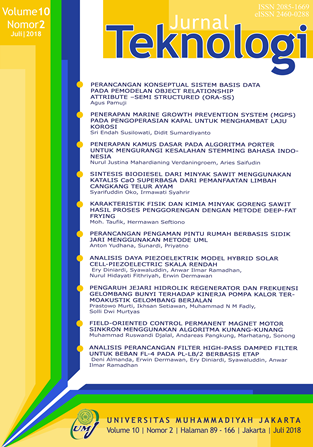PENERAPAN KAMUS DASAR PADA ALGORITMA PORTER UNTUK MENGURANGI KESALAHAN STEMMING BAHASA INDONESIA
Main Article Content
Abstract
Downloads
Article Details
COPYRIGHT POLICY
The author(s) of an article published in the Jurnal Teknologi retains ownership of the intellectual property rights in work (s).
PUBLISHING RIGHTS
The author(s) of an article published in the Jurnal Teknologi have unrestricted publication rights. The authors give the Jurnal Teknologi the right to publish the article and designate the Faculty of Engineering Universitas Muhammadiyah Jakarta Publishing as the original publisher of the article.
LICENSING POLICY
Journal of Mechanical Engineering and Sciences is an open-access journal that follows the Creative Commons Non-Commercial 4.0 International License (CC BY-NC 4.0), which states that:

Under this license, the reusers must give appropriate credit, provide a link to the license, and indicate if changes were made. Users may do so in any reasonable manner, but not in any way that suggests the licensor endorses users or their use.
Please take the time to read the whole license agreement (https://creativecommons.org/licenses/by-nc/4.0/). As long as reusers follow the license conditions, the owner cannot withdraw these freedoms. The following components are included under this license:
 Attribution: Users must provide appropriate attribution, including a link to the license, and indicate whether or not they made any modifications. Users are free to do so reasonably, but not in a manner that indicates the licensee approves of their usage.
Attribution: Users must provide appropriate attribution, including a link to the license, and indicate whether or not they made any modifications. Users are free to do so reasonably, but not in a manner that indicates the licensee approves of their usage.
 NonCommercial: Users may not use the material for commercial purposes.
NonCommercial: Users may not use the material for commercial purposes.
References
Afuan, L. (2013). Stemming Dokumen Teks Bahasa Indonesia Menggunakan Algoritma Porter. Jurnal Telematika vol.6, 34-40.
Agusta, L. (2009). Perbandingan Algoritma Stemming Porter dengan Algoritma Nazief&Adriani untuk Stemming Dokumen Teks Bahasa Indonesia. Konferensi Nasional Sistem dan Informatika, 196-200.
Al Ajeeli, A. T. (2016). An Intelligent Framework for Natural Language Stems Processing. Global Journal of Computer Science and Technology, 16(1), 22-38.
Apriyanti, T., Wulandari, H., Safitri, M., & Dewi, N. (2016). Translating Theory of English into Indonesian and Vice-Versa. Indonesian Journal of English Language Studies, 2(1), 38-59.
Bahtiar, A., & Fatimah. (2014). Bahasa Indonesia untuk Perguruan Tinggi. Bogor: IN-MEDIA-Bogor.
Brychcín, T., & Konopík, M. (2015). HPS: High Precision Stemmer. Information Processing and Management, 68-91.
Fadllullah, A., Kamudi, D. D., Nasir, M., Arifin, A. Z., & Purwitasari, D. (2016). Web News Documents Clustering in Indonesian Language using Singular Value Decomposition-Principal Component Analysis and Ant Algorithms. Jurnal Ilmu Komputer dan Informasi (Journal of Computer Science and Information), 9(1), 17-25. doi:10.21609/jiki.v9i1.362
Fitri, M. (2013). Perancangan Sistem Temu Balik Informasi Dengan Metode Pembobotan Kombinas TF-IDF untuk Pencarian Dokumen BerBahasa Indonesia. Jurnal Sistem dan Teknologi Informasi (JustIN), 1(1), 1-6. Retrieved from http://jurnal.untan.ac.id/index.php/justin/article/view/1319
Gupta, V., & Lehal, G. S. (2013). A Survey of Common Stemming Techniques and Existing Stemmers for Indian Languages. Journal of Emerging Technologies in Web Intelligence, 5(2), 157-161. doi:10.4304/jetwi.5.2.157-161
Karyono, G., & Utomo, F. S. (2012). Temu Balik Informasi pada Dokumen Teks Berbahasa Indonesia dengan Metode Vector Space Retrieval Al Model. Journal Seminal Nasional Teknologi Informasi & Komunikasi Terapan , 282-288.
Mandala, R., Koryanti, E., Munir, R., & Harlili. (2004). Sistem Stemming Otomatis untuk Kata dalam Bahasa Indonesia. Seminar Naional Aplikasi Teknologi Informasi, 29-35.
Novitasari, D. (2016). Perbandingan Algoritma Stemming Porter dengan Arifin Setiono untuk Menentukan Tingkat Ketepatan Kata Dasar. Jurnal String, 1(2), 120-129.
Pontis, S., Blandford, A., Greifeneder, E., Attalla, H., & Neal, D. (2017). Keeping Up to Date: An Academic Researcher’s Information Journey. Journal of the Association for Information Science and Technology, 68(1), 22-35. doi:10.1002/asi.23623
Rahimi, M., & Zahedi, M. (2014). Query Expansion based on Relevance Feedback and Latent Semantic Analysis. Journal of AI and Data Mining, 2(1), 79-84.
Roshdi, A., & Roohparvar, A. (2015). Review: Information Retrieval Techniques and Applications. International Journal of Computer Networks and Communications Security, 3(9), 373-377.
Ruban, S., Sam, S. B., Serrao, L. V., & Harshitha. (2015). A Study and Analysis of Information Retrieval Models. International Journal of Innovative Research in Computer and Communication Engineering, 3(7), 230-236.
Samsudin, D. (2015). Peran Media Dalam Pemasyarakatan Istilah Bahasa Indonesia. Metalingua, 13(2), 151-159.
Setiawan, R., Kurniawan, A., Budiharto, W., Kartowisastro, I. H., & Prabowo, H. (2016). Flexible affix classification for stemming Indonesian Language. 2016 13th International Conference on Electrical Engineering/Electronics, Computer, Telecommunications and Information Technology (ECTI-CON) (pp. 1-6). Chiang Mai, Thailand: IEEE. doi:10.1109/ECTICon.2016.7561257
Siroj, M. B. (2015). Pengembangan Model Integratif Bahan Ajar Bahasa Indonesia Ranah Sosial Budaya berbasis ICT bagi Penutur Asing Tingkat Menengah. Jurnal Pendidikan Bahasa dan Sastra Indonesia, 4(1), 74-84.
Tala, F. Z. (2003). A Study of Stemming Effects on Information Retrieval in Bahasa Indonesia. 1-33.
Utomo, M. S. (2013, Januari). Implementasi Stemmer Tala pada Aplikasi Berbasis Web. Jurnal Tekonologi Informasi DINAMIK Volume 18 no 1 , 41-45.
Vivekavardhan, J. (2015). Search Engines for User Centric Information Retrieval and Scholarly Communication. International Journal of Advanced Library and Information Science, 3, 201-211.
Zainuddin. (2016). A Study on Derivational Affixes of Indonesian Noun-Formation in Newspaper Editorial: A Semantic Perspective. International Journal of English Linguistics, 6(3), 148-155. doi:10.5539/ijel.v6n3p148

